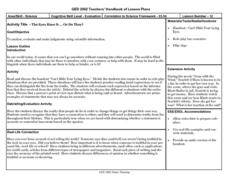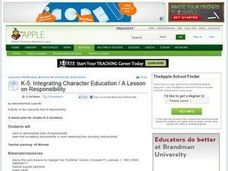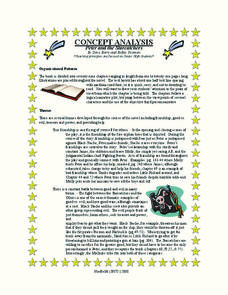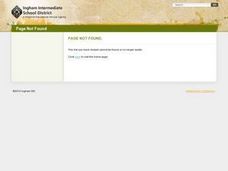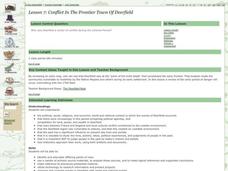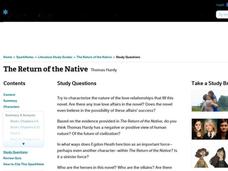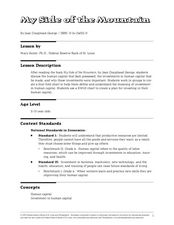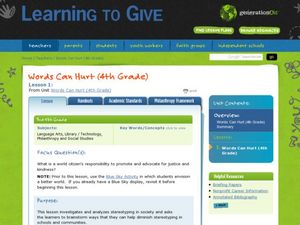Curated OER
Morphing
Pupils examine how organisms adapt to their environment in order to survive. As a class, they discuss the extinction of the dinosaurs and review Darwin's theory of survival of the fittest. They select an animal to morph in the future and...
Curated OER
Quilt Codes
Students list criteria to evaluate credible historical sources and defend their criteria in an essay. In this historical sources lesson plan, students review information of historical sources as well as the facts and pictures.
Curated OER
The Eyes Have It ... Or Do They?
Students explore facial expressions for the hidden meanings being communicated. Truth can be hidden or at least disguised by a particular expression. The reality of control and the manipulation of truth is discussed in this lesson plan.
Curated OER
K-5 Integrating Character Education/A Lesson on Responsibility
Students demonstrate traits of responsibility. They explain that accepting responsibility is more rewarding than avoiding responsibility. Students bring pictures of responsible and irresponsible situations or behaviors. They explore the...
Curated OER
Revolutionary War Era Research Project
Young historians interpret historical evidence presented in primary and secondary resources in this American Revolution lesson. They select topics from the time era that they are interested in researching. Additionally, they follow...
Curated OER
Peter and the Starcatchers: Concept Analysis
Are you preparing to teach Peter and the Starcatchers? If so, you'll want to take a look at this analysis of the text, which describes plot and literary elements in-depth and explores potential implications related to diversity and...
Curated OER
Not Only Paul Revere: Other Riders of the American Revolution
Students examine circumstances surrounding rides of the American Revolution other than Paul Revere's, explore why posterity treated them differently than Revere's ride, and create original poems based on historical fact.
Curated OER
Role Playing in North America: Mid 1600s-Mid 1700s
Eighth graders apply their knowledge of North American history from the mid 1600's through the mid 1700's to a role-playing scenario. In small groups they plan, write, and perform a dramatic skit of a group that was affected by events in...
Curated OER
Conflict in the Frontier town of Deerfield
Students use primary sources to investigate, explore and represent varying perspectives on the 1704 Deerfield Raid. They consider the reasons Deerfield was at the center of English, French and Native American conflicts in the early 18th...
Curated OER
MONSTERS AND MYTHS: SCRIPTS /SCULPTS
Seventh graders are introduced to myths formed by many cultures as a unique genre of literature. They use critical thinking skills to compare and contrast mythic tales, compare versions of the same story, and respond to literature in...
Curated OER
Burning Issues
Students study fire management. In this science lesson, students recognize and understand what they think would be the most responsible and appropriate actions to take in regards to fire managment.
Curated OER
The Return of the Native Study Questions
In this online interactive literature worksheet, students respond to 10 short answer and essay questions about Thomas Hardy's The Return of the Native. Students may check some of their answers online.
Curated OER
Finding the Stakeholders
High schoolers consider biomedical ethical issues. In this ethics lesson, students examine a case study about a boy with leukemia whose father refuses his blood transfusions based on faith. High schoolers consider the principles of the...
Curated OER
"My Side of the Mountain"
Learners demonstrate comprehension skills be retelling 6-8 significant events. They identify new vocabulary words and determine the meaning by using context clues.
They contribute to group discussion by sharing at least 1 idea/reflection...
Curated OER
Do You Haiku?
After examining several Haiku and noting characteristics of the form, class members create five of their own poems. Use this resource for extra practice or review.
Curated OER
Lesson 1: The Image of Maine in Sinclair Lewis' Babbitt
Students study excerpts from Sinclair Lewis, "Babbitt" for its accuracy and socio-economic point of view. They rewrite a portion of "Babbit" using the point of view of a Maine guide.
Curated OER
Go Yankees!
Students use the internet to research the New York Yankees baseball team. After gathering their information, they discuss the challenges faced by the team and how they were overcome. They end the lesson by examining the math and...
Curated OER
Lesson 2: Maine's Merchant Marines
Students simulate the quarters aboard a ship. They write a letter to Joanna Colcord or Alice Drinkwater that shows an understanding of the experience of being aboard ship, and asks further historical questions about the experience.
Curated OER
The Very Clumsy Click Beetle
Second graders determine what it means to be clumsy before listening to Eric Carle's, The Very Clumsy Click Beetle. They examine the part where the click beetle does flips before drawing three frames that show the beetle flipping. For...
Curated OER
Words Can Hurt: King Day
Students explore stereotyping. In this moral and character development lesson, students share reactions to a T-chart displaying what boys can do and girls can not do. Martin Luther King's accomplishments are discussed, and students...
Curated OER
Symbol Beneath the Surface in "The Life You Save May Be Your Own"
Learners identify the value of symbols in shorts stories and analyze Flannery O'Connor's use of symbolism. In this symbolism lesson, students complete a worksheet about symbols for cars. Learners answer questions about Flannery...
Curated OER
Word Power - Collocations
In this newspaper worksheet, learners match phrases with their definitions that often appear in the newspaper. Students complete 10 matches.
Curated OER
Natural Resources and Land Use
Seventh graders explore natural resources and land use. In this geography skills lesson, 7th graders view a PowerPoint presentation on the topics and discuss the distribution of natural resources and land use issues in East Asia. The...
Curated OER
It Counts
Students explore how numbers can identify objects. In this math lesson plan, students determine how numbers are used to describe objects used in quantitative data collection.


